|
 Cystoderma clastotrichum Cystoderma clastotrichum
SynonymsBaeospora clastotricha
Agaricus anthiceps
Omphalia anthiceps
BiostatusPresent in region - Indigenous. Endemic
Images (click to enlarge) | 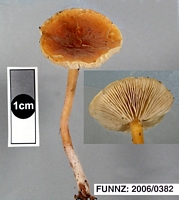
Caption: FUNNZ: 2006/0382, See public note for more information
Owner: FUNNZ | 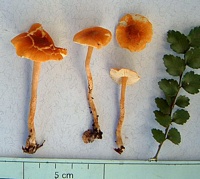
Owner: Karl Soop | 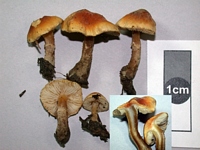
Owner: J.A. Cooper | 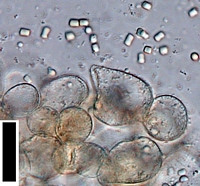
Caption: cap cells and arthropsores. Scale = 20um
Owner: J.A. Cooper | 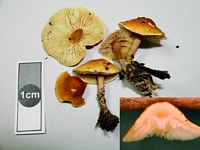
Caption: note flesh yellow.
Owner: J.A. Cooper | 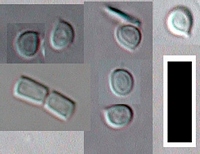
Caption: scale=10um. Spores and arthrospores.
Owner: J.A. Cooper | 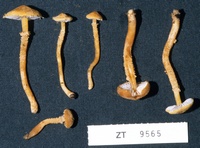
Caption: ZT9565
Owner: E. Horak: © Creative Commons Attribution-Noncommercial 3.0 New Zealand | 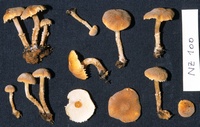
Caption: ZT9654, NZ-100
Owner: E. Horak: © Creative Commons Attribution-Noncommercial 3.0 New Zealand | 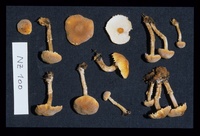
Caption: ZT9366, NZ-100
Owner: E. Horak: © Creative Commons Attribution-Noncommercial 3.0 New Zealand | 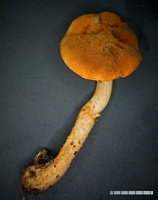
Owner: J.A. Cooper | 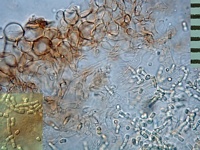
Caption: section through cap showing spherical cap cells and sub-cuticular arthrospores
Owner: J.A. Cooper | 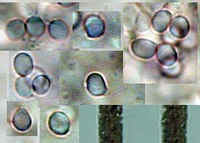
Caption: spores
Owner: J.A. Cooper | 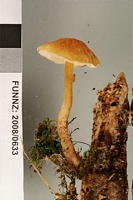
Owner: J.A. Cooper | 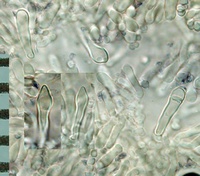
Caption: metuloid pleurocystidia
Owner: J.A. Cooper | 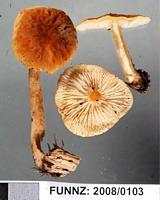
Owner: J.A. Cooper | 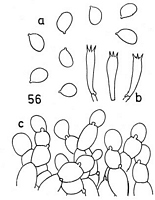
Caption: 56-Cystoderma clastotrichum: a. spores; b. basidia; c. cuticle. |
Article: Horak, E. (1971). A contribution towards the revision of the Agaricales (Fungi) from New Zealand. New Zealand Journal of Botany 9(3): 403-462 (http://www.rsnz.org/publish/abstracts.php).
Description: Baeospora clastotricha Stevenson (29 D) Fig. 3 = Cystoderma clastotrichum
(Stevenson) comb. nov. (Basionym: B. clastotricha Stevenson, Kew Bull. 19: 56,
1964).
This is undoubtedly a member of the genus Cystoderma which is represented in
New Zealand by more than four species, according to our present knowledge.
Cuticle consists of an epithelium formed by oval or roundish cells, with clamp,
connections. Spores oval, hyaline, smooth, amyloid, 3.5-4.5 X 2.5-3 µ. Cystidia
none.
Article: Stevenson, G. (1964). The Agaricales of New Zealand: V. Kew Bulletin 19(1): 1-59.
Description: Pileus 1-3.5 cm. diam., ochraceous yellow, darker at centre, intensely velvety, plano-convex with down-rolled margin; flesh yellow. Gills adnate, creamy-white, thin, crowded. Stipe 3-7 x 0.2-0.4 cm., ochraceous yellow, paler and silky striate above, more or less clothed with cottony fibrils below, occasionally peronate, hollow, tough. Spores 5 x 3 µm, amyloid, thin-walled; print white. Hymenophoral trama and hyphae of tissues non-amyloid. Basidia with amyloid granulation. Cuticle of globe cells, 15-20 µm diam., with ochraceous yellow pigment, some becoming amyloid, covered by abundant hair-like chains fragmenting into cylindric cells, 3-4 µm broad and 4-8 µm long, some becoming amyloid, containing ochraceous yellow pigment (Fig. 34). Strong unpleasant smell.
Habitat: On fallen wood or rooting' in litter in Nothofagus forest, Keith George Park, 15.6.1949 (Type); & 25-5-1952; Lowry Bay, 6.7.1949, Fringed Hill, Nelson, 3.6.1956; all Stevenson.
Notes: Although the peronate collections appeared different from the smooth-stemmed ones macroscopically, some were intermediate in this respect; all agreed in microscopic characters and thus are treated as one species.
Article: Massee, G.E. (1899) [1898]. The fungus flora of New Zealand. Transactions and Proceedings of the New Zealand Institute 31: 282–349 Wellington:.
Description: Densely tufted ; pileus deeply umbilicate, often somewhat umbonate but the umbo sunk in the
central depression, thin, even, glabrous, white, disc tinged brown, 1-1.5 cm. broad; gills
adnato-decurrent, distant, rather broad, white ; spores subglobose, 4-5 µ diameter; stem 1-1.5
cm. long, slender, glabrous, white, hollow.
Habitat: Densely caespitose, on decaying logs.
Distribution: New Zealand. Cuba.
Notes: Distinguished by the much-crowded habit, and the white pileus having the centre depressed
and tinged brown.
Article: Horak, E. (1971). A contribution towards the revision of the Agaricales (Fungi) from New Zealand. New Zealand Journal of Botany 9(3): 403-462 (http://www.rsnz.org/publish/abstracts.php).
Notes: Omphalia ? anthiceps Berkeley and Curtis (8, 16) Fig. 2 = Cystoderma
clastotrichum (Stevenson) Horak
The microscopical as well as macroscopical characters of the collection
(COLENSO b 1023) correspond in all details with this common New Zealand
species of Cystoderma, which was originally described as Baeospora
clastotricha Stevenson (see there).
|